Oranda (in Japanese – 和蘭獅子頭) is one of the artificially bred ornamental species of ‘goldfish’ for home aquariums (Carassius gibelio forma auratus), which is one of veiltail kinds, but it differs from them since it has fleshy outgrowths on its head and gill covers. The main distinctive feature is its “hood” on the head, which is called ‘wen’. Wen starts to appear in about 3-4 month after the birth, but it gets fully formed only 1-2 years later. However, you can say that the ‘hood’ is completely developed only when it is 2-2.5 years old.
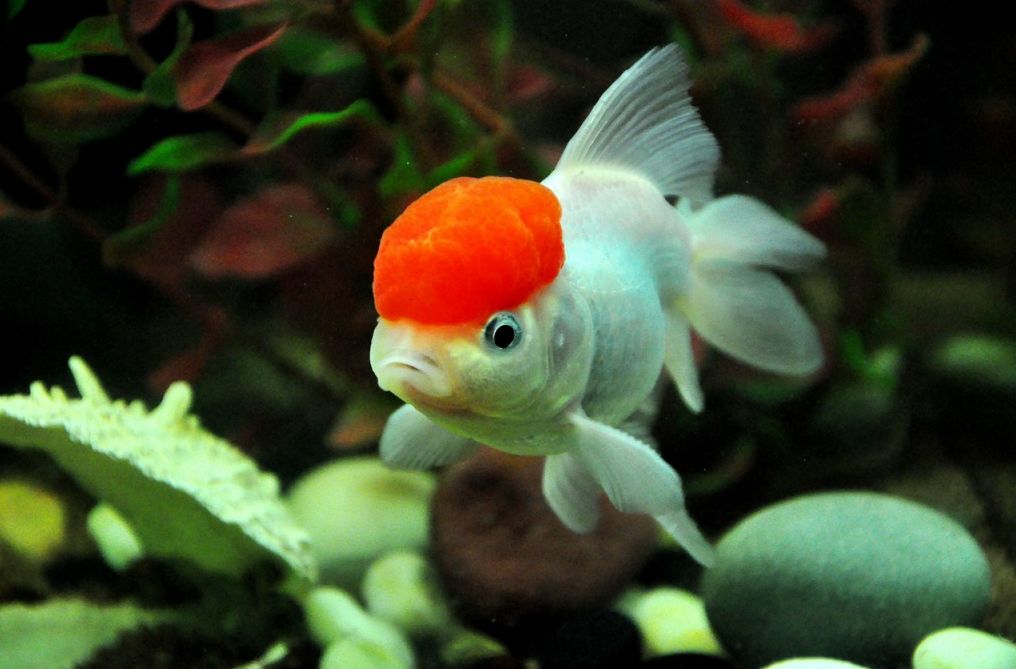
Contents
Habitat in the wild
The oranda goldfish (Carassius auratus) is a popular and beautiful variety of goldfish known for its distinctive appearance. It belongs to the family Cyprinidae, which includes many other types of freshwater fish like carp, minnows, and barbs. Goldfish, including orandas, have been selectively bred for centuries, resulting in a wide range of shapes, colors, and patterns.
Oranda goldfish is an ancestor of a wild fish from cyprinoid fishes family that initially inhabited in Asia and they originate from the goldfish. Natural habitat is in slow and lantic waters, rivers, ponds, lakes and drains.
The history of oranda goldfish can be traced back to ancient China, where goldfish were first domesticated over a thousand years ago. Initially, they were kept in ponds and eventually bred in captivity, leading to the development of various goldfish varieties, including the oranda.
The oranda goldfish is believed to have originated in the 1500s during the Ming Dynasty in China. It is thought to be a result of crossbreeding between the Chinese “Wakin” goldfish and the “Ryukin” goldfish, which were introduced from Japan. The Wakin contributed the long, single tail, while the Ryukin brought the hump or “wen” on the head.
The word “Oranda” comes from the Japanese term “oran,” which means “Dutch.” This name reflects the perception of the Dutch people as being exotic and foreign during the period when Japan first imported and adopted this variety of goldfish. It is important to note that while the name “Oranda” is of Japanese origin, the fish’s history and development occurred primarily in China.
During the 18th century, these goldfish were introduced to Japan, where they were further refined and selectively bred to enhance their unique characteristics, including the size and shape of the wen. The Japanese are credited with making significant advancements in goldfish breeding, including the establishment of strict standards for various goldfish varieties.
From Japan, the oranda goldfish, along with other fancy goldfish types, eventually spread to other parts of the world through trade and exploration. In the 19th and 20th centuries, goldfish became increasingly popular as ornamental fish in Europe and North America.
The selective breeding and efforts to refine the oranda and other goldfish varieties continued over the years, resulting in the wide array of colors and patterns seen in modern oranda goldfish.
Today, oranda goldfish remain one of the most sought-after and beloved fancy goldfish varieties. Their striking appearance, including the prominent head growth, continues to capture the attention of fish enthusiasts around the globe. The dedicated work of breeders over many generations has ensured that these beautiful fish are now readily available to hobbyists worldwide.
Description
Size
Oranda goldfish can grow to a size of about 8 to 12 inches (20 to 30 centimeters) in length. However, the fish grows that large only if it dwells in open waters. Some individuals may grow larger than the average range, while others might stay on the smaller side. Additionally, females tend to be slightly larger than males, especially when they are carrying eggs during the breeding season.
Lifespan
Lifespan is 10-15 years provided with good tank or open water conditions. However, with proper care and a healthy environment, they can sometimes live even longer, reaching up to 20 years or more. Providing a suitable and well-maintained environment, regular feeding of a balanced diet, and monitoring their health can significantly contribute to a longer and healthier life for oranda goldfish.
Body
Oranda goldfish have a rounded, egg-shaped body with a slightly arched back. This good looking fish has an oviform large body, shiny scales and claw-ended paired veiltail fin. It waves fanwise when the fish stops swimming and hovers. The rest of the fins except the dorsal one are also claw-ended. The head and gill covers are covered with fleshy outgrowths that develop as the grows.
Color
The color may vary greatly: red, orange, white, black, blue, chocolate, and calico patterns (a mix of colors). Oranda goldfish may also be calico colored – this is when the body is covered with bright colored spots all over.
One of the most distinctive features of the oranda goldfish is the growth of fleshy tissue on the top of their head, known as the “wen or crown.” The wen starts developing when the fish is still young and continues to grow as it matures. The size and shape of the wen can vary significantly between individual fish and can sometimes partially or completely cover the eyes.
| Characteristic | Description |
|---|---|
| Body Shape | Egg-shaped body with a dorsal fin and paired anal fins |
| Tail Shape | Long, flowing, single tail (without a fork) |
| Head Growth (Wen) | Fleshy outgrowth on the head, covering the skull |
| Color Variations | Various colors including red, orange, white, black, etc. |
| Size | Can grow up to 8-12 inches (20-30 cm) in length |
| Lifespan | Average 10-15 years with proper care |
| Temperament | Peaceful and social, can be kept in a community tank |
| Diet | Omnivorous, eats fish flakes, pellets, vegetables, etc. |
| Tank Size | Requires a spacious aquarium or pond |
| Water Temperature | 65-72°F (18-22°C) |
| Water pH | 7.0-8.4 |
| Water Hardness | Soft to moderately hard |
| Water Quality | Requires good filtration and regular water changes |
| Breeding | Egg-layers, breeding requires specific conditions |
| Difficulty of Care | Moderate, need attention to water quality and diet |

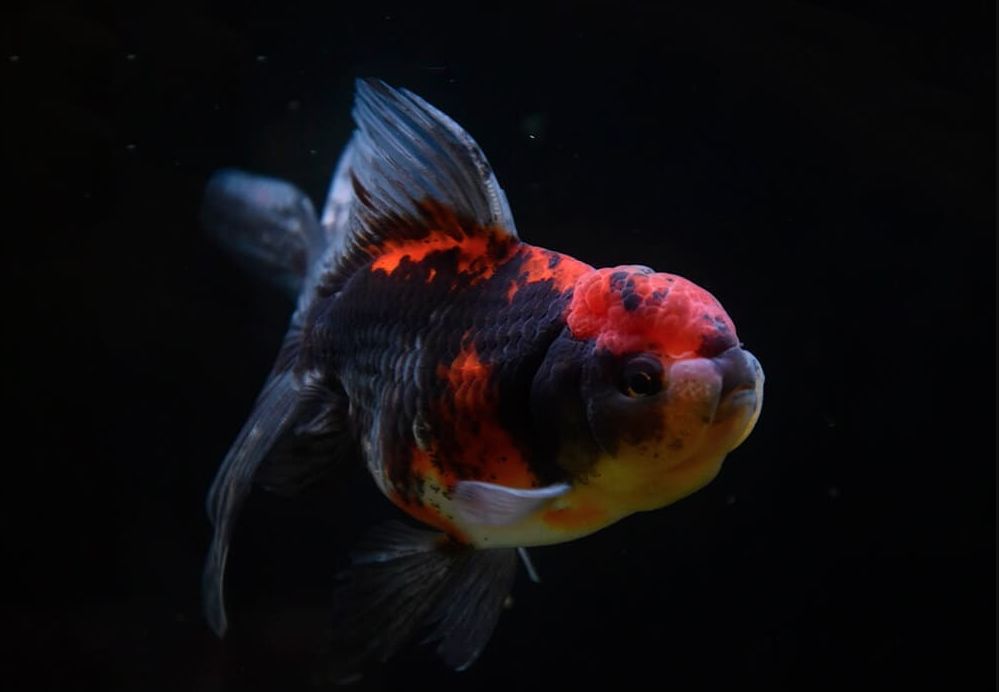
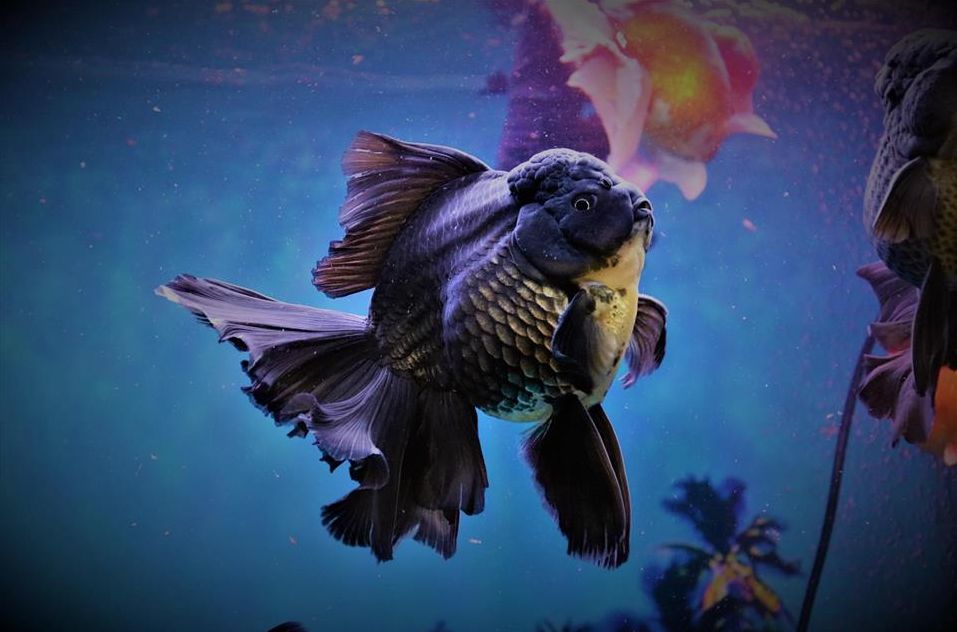
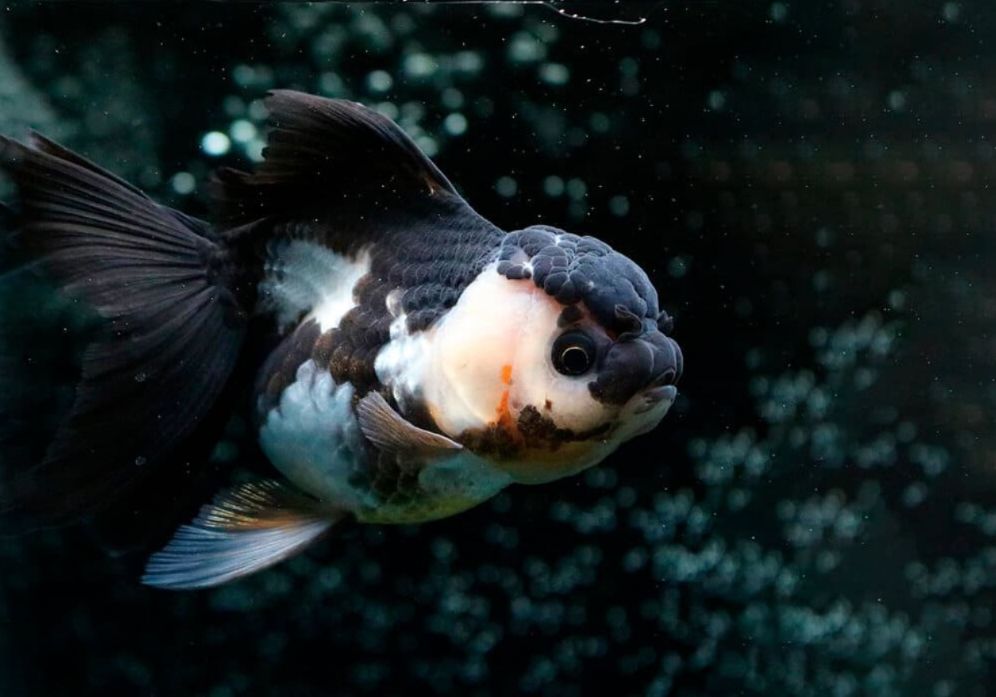
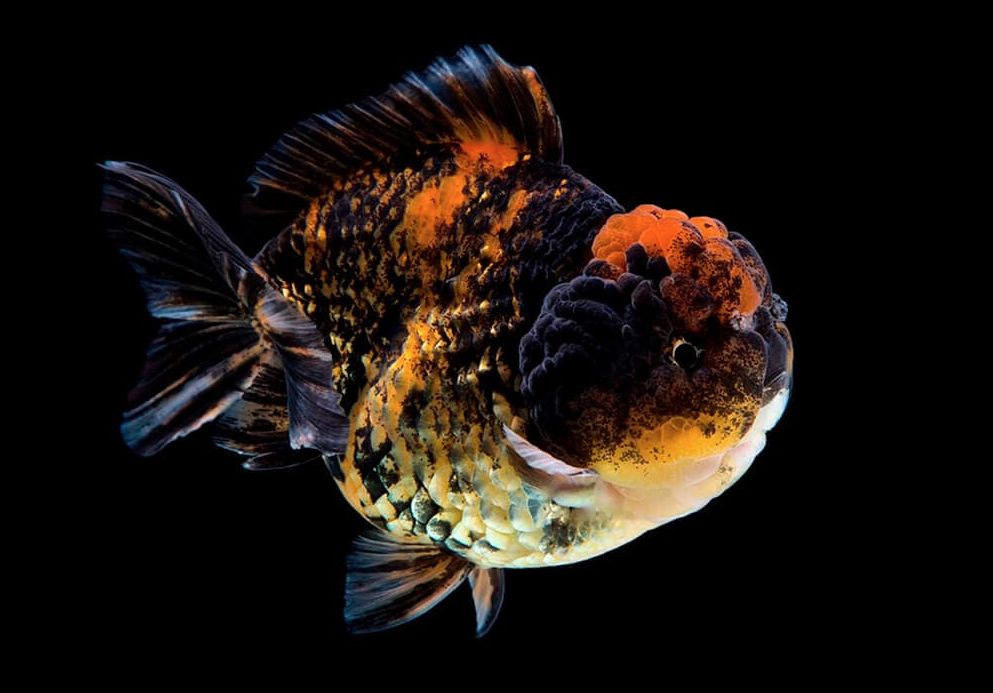
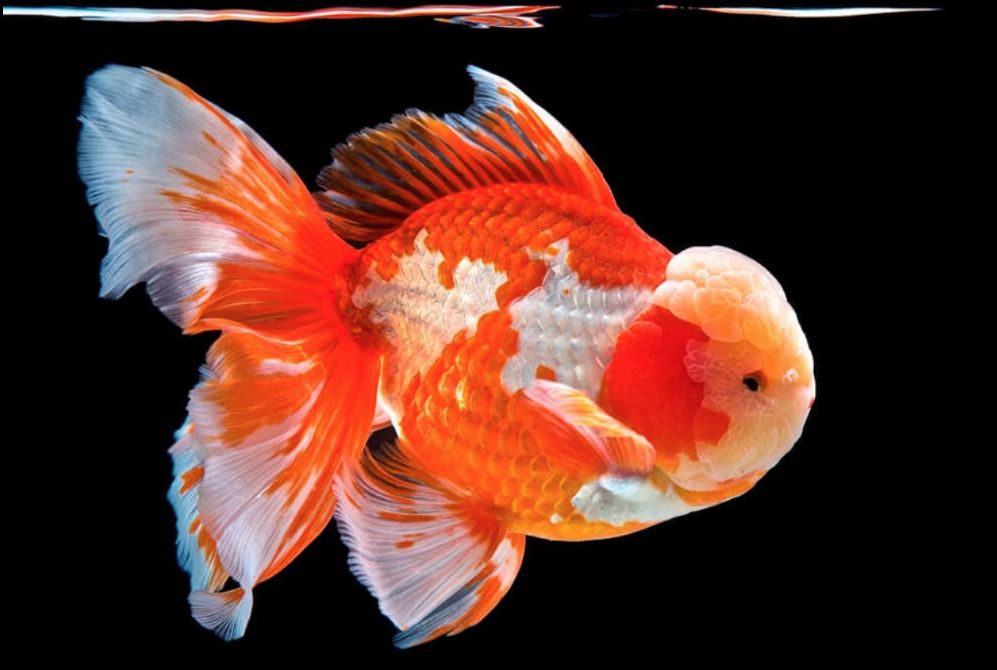
Difficulties in keeping
All goldfish species are rather not demanding, since they are ancestors of a common carp which dwells in cold water and isn’t demanding either. Quite often fish is kept in open waters and the water temperature there is lower than it is required for tropical fishes. Oranda goldfish is unpretentious as for the food as well.
Though, oranda goldfish can be encountered in tanks all over the world, it requires gentle treatment and therefore it is not recommend for beginner aquarists.
The oranda goldfish is quite sensitive to water cleanness and it can’t stand dwelling in cold water unlike its relatives with flat bodies – ordinary goldfish, comet fish etc.
Care and keeping in a tank
Oranda goldfish is one of the most demanding species among all the goldfish, so it’s not recommend for beginner aquarists to keep. The oranda goldfish is very sensitive to water contamination, its ‘hood’ is prone to various infections, bacteria and fungi, if the water is very dirty. The fish needs a lot of free space and proper care.
Tank size
It is also important to choose a proper tank for oranda goldfish. It has to be spacious, rectangular with large water surface area. If a small fish will be ok in a tank of 40 liters (8.8 gallons) capacity, still in the future you’ll have to buy a bigger tank. The oranda goldfish must have a room to swim.
That’s why from the very beginning it is recommended to get a tank of 30 gallons (approximately 113 liters) capacity for one fish and raise the tank volume at 10-20 gallons (38-76 liters) for the each oranda goldfish you put there. Providing more swimming space and water volume helps dilute waste and reduces the need for frequent water changes.
Large volume of water guarantees that you won’t have problems with tank water contamination with the rubbish that the fish produces in large amounts as well as you will provide your pets with sufficient amount of oxygen.
Water parameters
Here are the recommended water parameters for keeping oranda goldfish in an aquarium:
- Temperature: 65-72°F (18-22°C)
All goldfish prefer low water temperature 18°— 22 °C (65-71 °F), however oranda goldfish can’t stand very low water temperature. That’s why we don’t recommend to decrease water temperature in the tank with oranda lower than 16 °C (60 °F). - pH Level: 7.0-8.0
Oranda goldfish can tolerate a wide range of pH levels, but ideally, the water should be slightly alkaline. - Ammonia and Nitrite: 0 ppm
Ammonia and nitrite are highly toxic to fish, and their levels should always be kept at zero. Regular water testing is essential to ensure these parameters remain safe. - Nitrate: Below 40 ppm (ideally lower)
Nitrate is a byproduct of the aquarium’s nitrogen cycle and should be regularly removed through partial water changes. Elevated nitrate levels can stress the fish and negatively impact their health. - General Hardness (GH) and Carbonate Hardness (KH): Moderate to moderately hard
Orandas can adapt to a range of water hardness levels. Moderate hardness is generally suitable for their well-being.
It’s important to note that stable water parameters are crucial for goldfish health. Sudden fluctuations or poor water quality can lead to stress, weakened immune systems, and various health issues.
To maintain optimal water conditions:
- Use a reliable water testing kit to monitor ammonia, nitrite, nitrate, pH, GH, and KH levels regularly.
- Perform partial water changes (about 25-30% of the tank volume) weekly or as needed to remove accumulated waste and reduce nitrate levels. If the tank is too small or overcrowded you should renew the water in larger amounts and more often.
- Invest in a good quality aquarium filter to remove excess waste and maintain water clarity. The tank must have a canister filter that effectively cleans water from various contaminants. Biological filtration is required as well.
- Avoid overfeeding, as uneaten food can lead to increased ammonia levels.
By ensuring proper water parameters and providing a clean and well-maintained environment, you can help your oranda goldfish thrive and live a healthy and happy life.
Substrate
The tank bottom should be covered with smooth gravels that will not hurt the oranda goldfish (fish likes digging the bottom). When using gravel, choose larger-sized particles (around 3 to 5 mm) to prevent the goldfish from accidentally ingesting it while foraging at the bottom.
Some aquarists prefer using smooth river rocks as a substrate. Ensure the rocks are large enough not to be accidentally swallowed by the goldfish.
In certain cases, keeping the tank bottom bare is an option, especially in quarantine tanks or if you have difficulty maintaining the tank cleanliness with a substrate. A bare bottom tank makes cleaning easier and reduces the risk of debris buildup.
Tank decor
You may put some decorations into the tank, but be careful if they have some sharp edges. All decorations including stones and snags also shouldn’t have any sharp sides, since the fish may hurt its fins or fleshy outgrowths. So, keep this fact in mind when choosing decorations for a tank.
Tank plants may be both live and artificial ones, but live plants should have strong roots and coarse leaves, otherwise oranda goldfish will gladly eat them. So, plants with large and coarse leaves or just ‘not tasty’ plants such as anubias will do for the tank. These plants will not be eaten and the tank environment will benefit from them.
Oranda goldfish doesn’t tend to jump out of the tank that’s why a cover-glass or a lid are needed only to avoid water evaporation. Tank lighting also is not very important, since only tank plants require it as well as you to observe your pets comfortably.
Though tank lighting is not important for the fish, but this is when you can see all the beauty and unicity of the species.
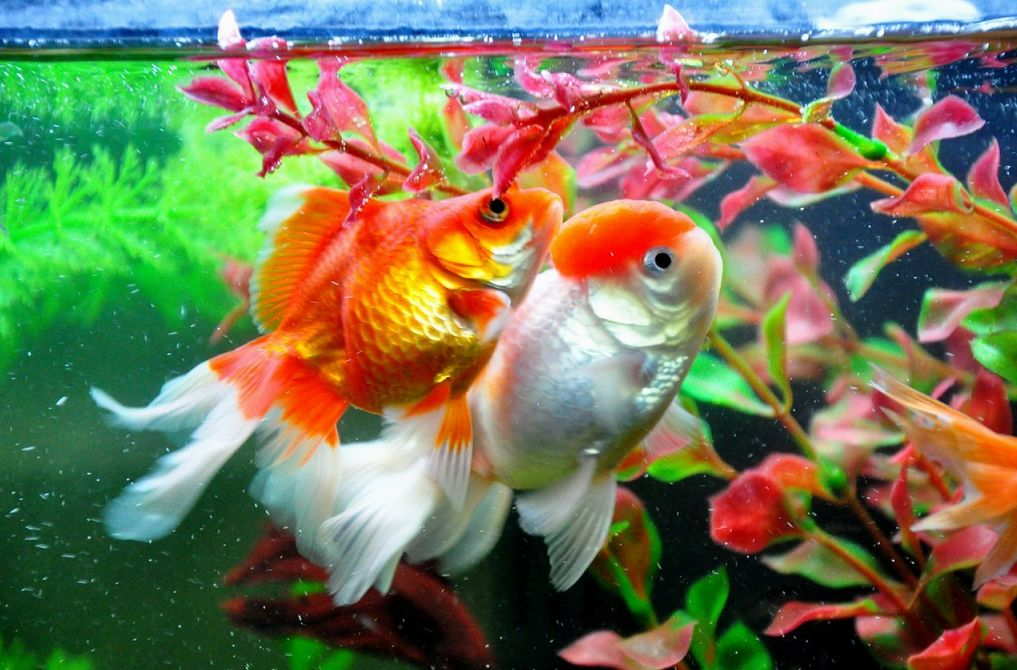
Tank mates
When choosing tank mates for oranda goldfish, it’s essential to consider their peaceful temperament and slow-moving nature. They are generally compatible with other peaceful and slow-moving fish that can tolerate the same water conditions.
Here are some suitable tank mates for oranda goldfish:
- Other Goldfish: The best tank mates are goldfish species similar to this one. Orandas can be kept with other fancy goldfish varieties like Ryukins, Fantails, Ranchu, or other Orandas. It’s essential to ensure that the tank is large enough to accommodate multiple goldfish comfortably, as they can grow to a significant size. Oranda is not a very good swimmer as well, therefore don’t keep it with such active swimmers as a common goldfish or shubunkin.
- Bristlenose Plecos: These algae-eating catfish can help keep the tank clean and are generally peaceful. Just ensure you have enough space as they can grow up to 5-6 inches (12-15 centimeters) in length.
- Corydoras Catfish: Corydoras are bottom-dwelling catfish that are peaceful and can add activity to the lower part of the tank.
- Mystery Snails: These snails can help with algae control and are generally compatible with goldfish.
Always keep in mind the following tips when choosing tank mates for oranda goldfish:
- Avoid aggressive or fin-nipping fish (like tiger barb), as they may harass the slow-moving and long-finned orandas.
- Don’t keep them with fish that may outcompete them for food. Orandas can be slower eaters due to their head growth (wen), so it’s essential to ensure they get enough food.
- Ensure that the tank is adequately sized to accommodate all the fish comfortably. Overcrowding can lead to stress and health issues.
- Regularly monitor the tank to ensure all fish are getting along and there is no aggression or stress.
Remember that individual fish have their personalities and temperaments, so there can be some variation in how they interact with tank mates. Always be prepared to provide separate housing if any compatibility issues arise. Introducing new fish to the tank should be done gradually and with close observation to minimize stress for all the inhabitants.
Diet
The diet of oranda goldfish should be well-balanced and provide them with the necessary nutrients for their health and growth. Orandas are omnivores, which means they eat both plant matter and small aquatic creatures.
Here are some key components of an ideal oranda goldfish diet:
- Commercial Goldfish Pellets: High-quality commercial goldfish pellets should form the staple of their diet. Look for pellets specifically formulated for goldfish, as they contain essential nutrients and vitamins. Pellets that sink slowly are preferable, as orandas tend to feed at the bottom.
- Live or Frozen Foods: Offer occasional live or frozen foods to provide variety and mimic their natural diet. It usually eats live and frozen food: brine shrimp, daphnia, tubifex. These foods can be fed as treats, not as the primary diet.
- Fresh Vegetables: The latter is very important for the digestive system. Digestive tract of the oranda goldfish is quite tortuous and considering that the fish is an omnivorous one its digestive tract is often clogged with food. Then the oranda goldfish gets sick, swims poorly and dies in the end. The food with large amount of vegetable components is useful for the digestive system and prevents bowel retention. Oranda goldfish enjoy fresh vegetables, which also help with their digestion. You can offer blanched or boiled peas (with the outer skin removed), zucchini, spinach, lettuce, and cucumber. Vegetables should be chopped into small, bite-sized pieces before feeding.
- Spirulina or Algae-Based Foods: Spirulina-based flakes or pellets are beneficial for oranda goldfish. These foods contain algae and provide essential nutrients while enhancing their vibrant colors.
- Avoid Overfeeding: Goldfish have a tendency to overeat, leading to health issues. Feed them in small portions multiple times a day rather than one large feeding. They should consume all the food within a few minutes. If there are leftovers, remove them to maintain water quality.
Gender differences: male vs female
Determining the sex of adult oranda goldfish can be a bit challenging, especially outside of the breeding season, as they do not exhibit prominent external differences. However, there are a few subtle characteristics that can sometimes help distinguish between male and female oranda goldfish:
- Body Shape: In general, female may appear rounder or more full-bodied compared to males, particularly when they are carrying eggs during the breeding season. However, this difference may not be very pronounced, and body shape alone is not a reliable method for sexing goldfish.
- Vent Position: The vent is the opening located near the anal fin. In mature females, the vent may appear slightly larger and more rounded compared to males, which might look smaller and more pointed. However, this can be challenging to differentiate unless you have experience sexing goldfish.
- Breeding Tubercles: During the breeding season, male may develop small white or whitish bumps called breeding tubercles on their gill covers and pectoral fins. These tubercles are used for stimulating the female during spawning. However, not all males will develop prominent tubercles, and some females may also have tiny tubercles, making this method unreliable.
- Behavior: In some cases, males may exhibit more territorial or aggressive behavior, especially during the breeding season. However, behavior alone is not a definitive indicator of sex.
- Comparison: If you have both male and female orandas in the same tank, you may be able to observe differences in behavior and interactions between them, which could give you some clues about their sex. For example, males might chase females during breeding attempts.
To accurately sex oranda goldfish, especially for breeding purposes, it is best to observe them during the breeding season and look for more obvious signs of sexual dimorphism. However, even experienced hobbyists can sometimes find it challenging to determine the sex of oranda goldfish without more invasive techniques like ultrasound or examination of their reproductive organs.
For most hobbyists, determining the sex of oranda goldfish is not crucial for their care. Providing a suitable environment, proper nutrition, and good water quality are far more important for the health and well-being of your fish.
Breeding
It is not difficult to breed the oranda goldfish, but it seldom happens that all the juveniles are of high-quality. The oranda goldfish becomes reproductive at the age of 1.5-2 years. When the spring comes and days become longer you’ll see that male are ready to spawn and they actively haunt the females.
At the same time white grains appear on the male head and gill covers and notches appear on pectoral fins. Usually aquarists separate males and females before spawning. For breeding they get a spawning tank of 50 liters capacity and put a protective net into it.
Put a bunch of small leaved plants or just a net (which is better) into the spawning tank. Take 1 oranda goldfish female and 2-3 male for spawning. The fish starts laying eggs in the early morning and it lasts for several hours. Female lays about 2000 eggs.
The larvae appears in 2 days. On the 5th day the juveniles start to swim. Juveniles should be fed with rotifers and brine shrimps.